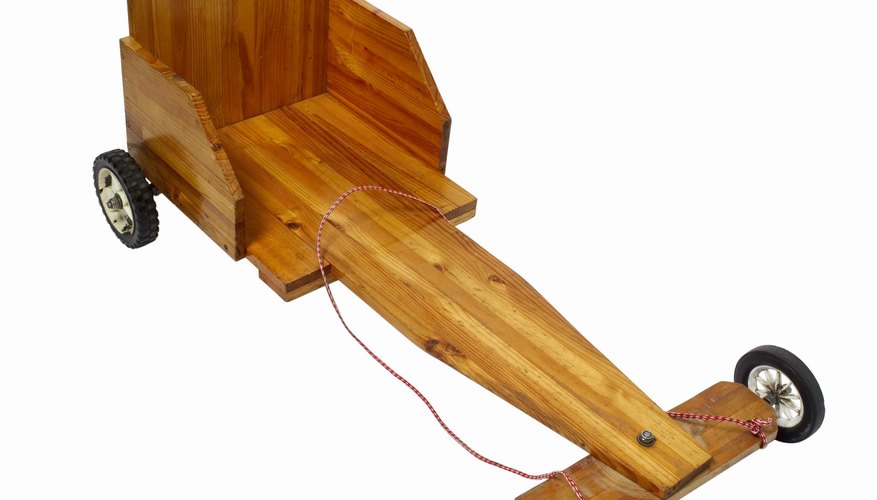Nothing says a childhood summertime quite like a go-kart. Although less popular in the UK than they are in America, home-made go-karts are a great way to create a practical toy that can give years of fun. Making a go-kart that propels itself is not only possible, it can be done relatively cheaply.
Gathering materials
Collect some wood. Have a good hunt through the garage for old pallets, shelves, bed frames, wardrobes, and any other wooden items made from straight planks. You might also be able to source wood from the local tip, or from friends or neighbours. Finding the wood for free is the key to keeping down the cost of your go-kart.
Find some wheels. Lots of items have wheels that are perfect for go-karts. Lawnmowers, prams and children's bicycles are all good choices. A visit to the local tip will usually result in a good variety. Aim for wheels with thick rubber tyres that will be hard wearing over bumpy terrains.
Plan the assembly of your kart. A kart can be any shape, but a rectangle is usually favoured. Draw a plan, and use a pencil to label each piece of wood so that they don't go amiss during the construction phase. Make sure to set aside a particularly strong plank of wood for the floor of the car.
Strip the engine from a lawnmower. The ideal type is a two-cycle engine. These can be easily removed by lifting of the outer casing of the lawnmower. Be sure to disconnect the spark plug before attempting to remove the engine, and be sure to check some of the videos on YouTube if you are not entirely confident with this part of the process (see the "resources" section below).
Find a seat. The seat from a ride-on lawnmower is the obvious choice for this, but with a little imagination there are lots of possibilities that can be utilised. Simple cushions from a sofa are easily available and can provide a very comfortable alternative to a traditional seat.
- Have a good hunt through the garage for old pallets, shelves, bed frames, wardrobes, and any other wooden items made from straight planks.
- The seat from a ride-on lawnmower is the obvious choice for this, but with a little imagination there are lots of possibilities that can be utilised.
Making the go-kart
Build the frame. You should already have the wood ready to assemble, so this part of the project simply involves using a hammer and nails to fix everything in place. Take care to ensure that there are no sharp points sticking out.
Attach the front part of the chassis. For this you will need to use a nut and bolt rather than nails, as this will allow for steering. When you have attached the front part of the chassis, the kart will be a "T" shape.
Nail the chassis to the centre plank. This will make your kart look like a capital "H" instead of a "T."
Add the wheels. Take four wooden blocks and drill a hole in each. Attach the blocks to the underside of your go-kart. If you have wheels that come with a full axle, unscrew one wheel and slide the pole through. If you have four separate wheels, use a bolt and a partially tightened nut. Self-tightening nuts and bolts will help to reduce the risk of a wheel coming loose whilst using the kart.
Reattach the lawnmower engine. This should be placed on the back of the go-kart, making sure that the propulsion-pulley section can turn one of the back wheels. There is no hard and fast rule for where to attach the engine, so you may want to experiment in order to find the best fit. The original fittings may be salvageable depending upon the type of lawnmower you have taken the engine from.
Attach the fan belt. This is probably the most difficult part of the entire process, so be prepared for some fiddly work. The belt needs to go around the engine pulley and the wheel axle, and should be tight when it is fixed. Have some spare wood on hand to move the engine back to gain the correct tension if necessary.
Add a steering system. The easiest way to do this is to drill two holes into the axle and thread two pieces of string or rope. There are many variations on this, however. For instance, you can use a single piece of rope threaded through both holes to create a steering "wheel".
Add the seat. Seats can be tied in place, or screwed in place if you are using a pre-manufactured seat from a lawnmower. Go-karting is synonymous with the occasional bump and scrape, so it is a good idea to work hard to ensure that the seat will remain fixed in the event of a collision.
- You should already have the wood ready to assemble, so this part of the project simply involves using a hammer and nails to fix everything in place.
- When you have attached the front part of the chassis, the kart will be a "T" shape.
- Go-karting is synonymous with the occasional bump and scrape, so it is a good idea to work hard to ensure that the seat will remain fixed in the event of a collision.
TIP
Add seat belts for extra safety. These can be salvaged from a scrap yard or sourced online.
If the kart is going to be used after dark, bicycle lamps will help to improve visibility and road safety.
WARNING
Never use a go-kart on a major road. Go-karts are low to the ground and comparatively slow moving, so they are difficult for cars to see and avoid.
